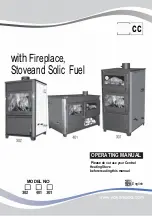
18
GB
•
place 2 firelighter blocks in the centre of the grate
•
create a pyramid of 8 to 10 pieces of tinder about 3 cm thick and 25 cm long around the firelighter blocks
•
light the firelighter blocks and leave the door slightly ajar
•
once the fire is burning well and there is no more condensation on the window, close the door
•
when the wood-burning stove is hot, close the flue gas valve by pushing the lever (on the left behind the wood-burning
stove) to the right
•
do not add any more wood to the wood-burning stove, simply allow the wood-burning stove to go out and cool to room
temperature
•
repeat this procedure 3 times
•
then repeat the procedure one more time, but this time add 1 kg of wood and allow the wood-burning stove to go out
again
•
repeat this procedure 3 times
When you light the Pecan Eco for the first time, the hearth must still ‘anneal’ and temper itself. The unit has a heat resistant
lacquer which must burn in the stove at temperatures above 400 °Celsius. This will happen during the first few times of
lighting the stove and temperatures rise to 600 °C. Though this may give an unpleasant smell, it is otherwise harmless. It is
advisable to keep the stove burning with limited fuel for at least 6 hours when lighting the stove for the first 4 or 5 times. Air
the room well when the stove is burning. Make sure that any cooking hood is not turned on when the stove is burning; a
cooking hood extracts the combustion air that the stove needs.
Some deposit may form on the glass panes of the stove when you ‘anneal’ your hearth. You can easily remove this deposit
with a damp cloth after the stove has cooled down. You can also use some cleansing agent for ceramic rings. Please make sure
you do not leave any finger marks on the clean glass. Finger marks burn into the glass and cannot be removed later.
Newly built house or recently renovated?
It is advisable to wait six weeks before lighting the stove in a newly built house that has recently been
completed, or in a space that has recently been renovated drastically. The walls and ceilings still contain
gases, softeners and moisture from plasterwork or paint. The warm air-streams may discolour the dust
particles in the space, which may stick to walls and ceilings. Even the moisture in the walls and ceilings will
become warm and may cause yellow stains.
HI2 Insides
The HI2 insides were specially developed for WFS and, without giving away too much of our secret
recipe, comprise a mix of special concrete with vermiculite. The heat-reflective action of the vermiculite
generates heat build-up in the combustion chamber while the rest of the material stores the heat.
Once combustion is well under way, you will see a perfect fire – clean, eco-friendly combustion with a
high heat yield.
The fire bricks, weighing in at some 30 kg, initially require thorough heating. The heat in the combustion chamber is key to
ensuring the stove works properly. We therefore advise getting the fire going with thinner, more easily combustible wood.
Leave the doors slightly ajar for a quarter of an hour so the fire quickly starts to burn fiercely.
If you then ensure a red-hot bed of ash for further combustion, this will create decent flames and radiant heat that you can
enjoy for the rest of the evening, while occasionally adding fresh wood.
The heat is stored by the fire bricks - known as accumulation - so any fresh logs ignite quickly. This accumulating action means
that the stove continues to give off heat for a long time after the fire is extinguished.
The HI2 insides are made using water, so the moisture will have to be heated out of the fire bricks during the first few sessions.
Our advice is to get a really good fire going for the first few hours. At that point, the fire will probably not look like it did in the
showroom, but the appearance will improve rapidly after the first couple of fires.
Summary of Contents for pecan eco s
Page 40: ...40 FR...
Page 54: ...54 DE...
Page 55: ...55 fig 01 fig 02 fig 03 fig 04 fig 05 fig 04a...
Page 56: ...56 fig 07 fig 11 fig 08 fig 09 fig 10 fig 06...
Page 57: ...57 fig 14 fig 12 fig 13 fig 13a...
Page 58: ...58 fig 15 fig 16 fig 17...
Page 61: ...61 Top down OND 0170 optional Alluminium grip...
















































